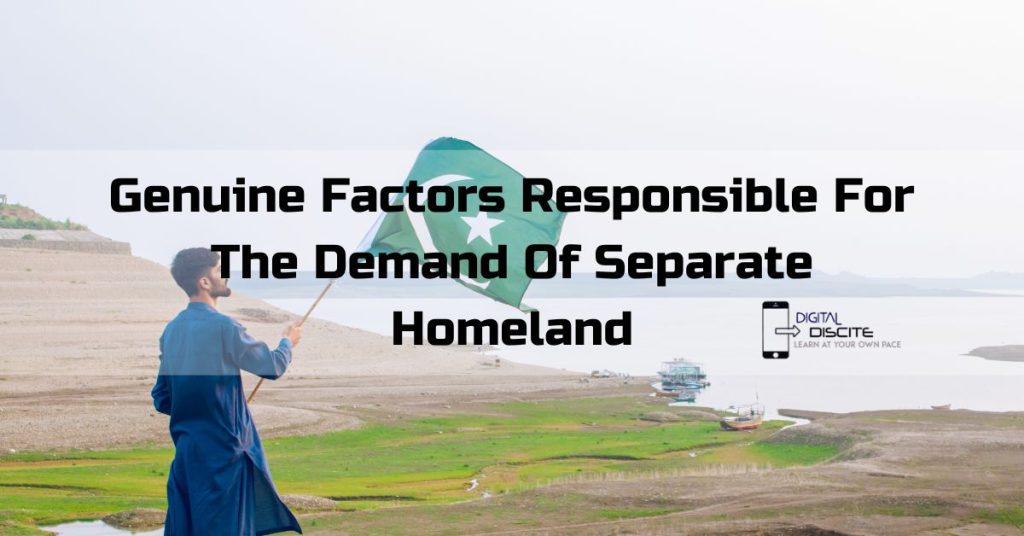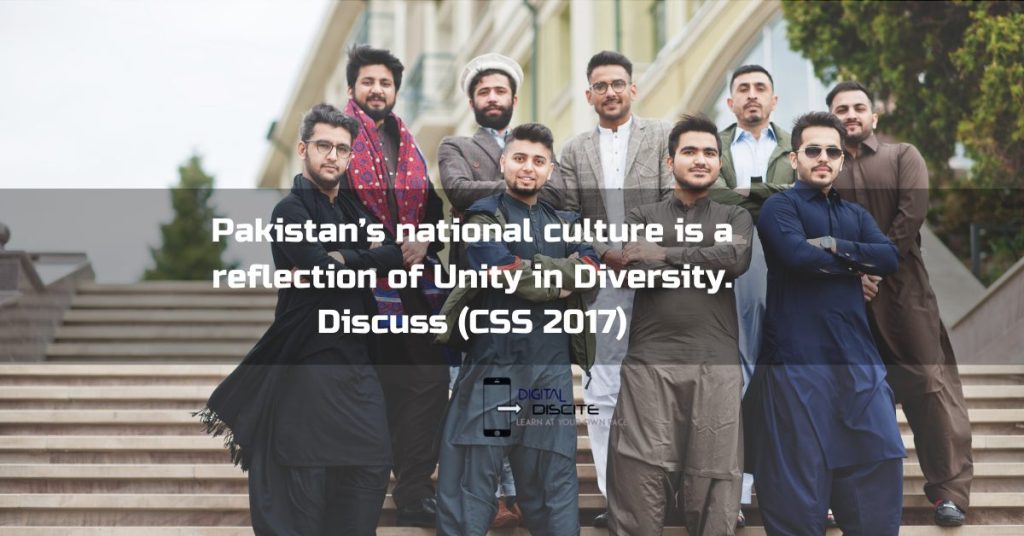Genuine Factors Responsible For The Demand Of Separate Homeland (CSS 2014)
I. Introduction: Genuine Factors Responsible For The Demand Of Separate Homeland
The creation of Pakistan was an evolution, not an event, and the causes for its emergence had started taking place much earlier. Twenty-Third March 1940 is a landmark day in Pakistan’s history.
On this day, Muslims put forward the demand for a separate homeland. The genuine factors that led Muslims to demand a separate homeland include the anti-Muslim practices by Hindus.
Besides this, the speeches of Quaid-e-Azam further strengthened the demand for a separate homeland.
II. Factors That Forced Muslims To Demand For Separate Homeland
The factors responsible for the demand of separate homeland, which forced the Muslims of India to seek independence, were:
1. Establishment of Congress
The primary motive behind the formation of the Indian National Congress was to strengthen the union between the British and India. Although initially intended to be secular, the Congress gradually became more representative of Hindu interests, largely neglecting the political and cultural concerns of the Muslim community.
This lack of representation and growing Hindu-centric agenda within the Congress led to a sense of marginalization among Muslims, ultimately motivating their demand for a separate homeland where their rights and identity could be safeguarded.
2. Partition of Bengal
Lord Curzon divided Bengal in 1905, citing administrative challenges as the primary reason. The partition aimed to improve governance, as the Bengal province was not only vast in area but also densely populated, with limited means of communication, making efficient administration nearly impossible.
However, Hindus viewed this decision as a threat to Bengali nationalism, interpreting it as an attempt to weaken their influence. Consequently, they launched a vigorous anti-partition movement, rallying for the reunification of Bengal.
Their protests eventually led to the annulment of Bengal’s partition in 1911, a decision that left the Muslim community disheartened.
For Muslims, the reversal revealed the extent of Hindu opposition, particularly since the partition had initially created East Bengal as a Muslim-majority province, offering them a sense of political and social security.
This incident solidified the belief among Muslims that Hindus would oppose any measure favoring Muslim interests, deepening the divide and reinforcing the demand for a separate homeland where Muslims could safeguard their rights and identity.
Furthermore, the factors responsible for the demand of separate homeland were rooted in the desire for political autonomy, cultural preservation, and the fear of marginalization in a predominantly Hindu society.
3. Urdu-Hindi Controversy
The Hindi-Urdu controversy began in the year 1867 when Hindus demonstrated against Urdu and demanded its replacement with Hindi as an official language.
According to Paul Brass, “The Urdu-Hindi controversy of the 19th century was the critical factor in the development of Muslim separatism,” suggesting that this conflict was a turning point in the formation of a distinct Muslim identity.
Dr. K.K. Aziz also argued that this linguistic rift contributed significantly to Indian disunity, as it laid the groundwork for multiple nationalistic movements within the subcontinent.
The controversy thus played a pivotal role in fueling the demand for a separate Muslim homeland, reinforcing the belief that linguistic and cultural identities required their own autonomous space.
Additionally, the factors responsible for the demand of separate homeland included the perceived marginalization of Muslims in political and social spheres, the need for cultural preservation, and the growing sentiment of self-determination among the Muslim community.
4. Nehru Report
This report not only widened the communal divide but also strengthened the foundation of the Two-Nation Theory, reinforcing the belief that Muslims required a separate homeland to protect their cultural and political identity.
Moreover, the factors responsible for the demand of separate homeland included the consistent marginalization of Muslim voices in political discourse, the lack of adequate representation, and the growing apprehension of losing their distinct cultural identity within a Hindu-majority framework.
5. Congress Election 1937
Election 1937 and 1937–1939 Congress ministries were the blueprint for Pakistan that they were the events which showed the real pictures of Hindus. After the election of 1937, Congress won the majority seats and came to power.
Twenty-seven months of Congress rule were characterized by rising political Hinduism, which seemed to be working only for the welfare of Hindu community and revenging the previous 700 years Muslim rule over them. Educational reforms were introduced that were purely anti-Muslim in spirit.
The purpose of Warda Taleemi scheme was to displace the idea of two-nation theory from minds of Muslim children, while Vidya Mandar scheme aimed at promoting Hindu culture and making Mandar education necessary at elementary level. Muslims were also kept back in economic circle.
They were expelled from government offices, and career opportunities were closed to them. This environment of exclusion and discrimination forced Muslims to recognize the factors responsible for the demand of separate homeland from the British, which included the need for political autonomy, protection of their rights, and preservation of their cultural identity in the face of a dominant Hindu agenda.
III. political struggle by quaid-e-azam through his speeches
Following the political struggle of Quaid-e-Azam for the separate demand of a Muslim state:
1. Unity
Quaid-e-Azam made multiple efforts to foster unity between Muslims and Hindus, striving for a cooperative political environment. Key initiatives included the Delhi Proposal and the Lucknow Pact, which aimed at bridging communal differences and ensuring political cooperation.
He even took the significant step of joining both the Congress and the Muslim League, hoping to mediate and resolve the disparities between the two communities. However, the outright disregard for Muslim interests in the Nehru Report was a turning point for him.
This experience led him to the realization that Muslims and Hindus, with their distinct political and cultural identities, could not coexist under a single administration that would truly represent both communities equitably.
2. Quaid-e-Azam Speech on 23 March, 1940
In his address in the meeting of the Muslim League on 23 March 1940, at Lahore, Quaid-e-Azam explained the ideological basis of an Islamic state as follows:
“Hinduism and Islam are not merely two religions but they are two separate social systems. It would be a dream to think that Hindus and Muslims will form a common nation. I want to make it clear that both the nations belonged to two different civilizations and the foundation of these two civilizations is on such philosophies which are opposed to each other.“
Quaid-e-Azam stressed that the differences between Hindu and Muslim communities extended far beyond religious practices—they represented fundamentally distinct approaches to life, law, and governance.
Hinduism and Islam each encompassed unique social values, customs, and legal principles that shaped separate ways of life.
For him, this divergence in civilizational foundations made the idea of a unified nation unrealistic and underscored the necessity of a separate state where Muslims could fully realize their cultural and ideological aspirations.
3. Separate Status of Muslim Nation
In January 1941, Quaid-e-Azam elaborated the separate status of Muslim nation by saying:
“India had never been a single country or a nation. The issue of sub-continent is international. The difference on culture, social and economic values are ideological in nature.“
With these words, he highlighted that India’s vast diversity was more than just regional or linguistic—it was deeply rooted in contrasting ideologies that shaped every aspect of life.
Quaid-e-Azam argued that the subcontinent’s history had been marked by separate civilizations with unique worldviews, and that the Muslim community’s identity was incompatible with a unified national framework.
His statement underscored the need for an independent homeland where Muslims could govern according to their own ideological, cultural, and economic values, free from any majoritarian dominance.
4. Nothing in Common
Once he (Quaid-e-Azam) said: “Hindus and Muslims had nothing in common other than the fact that they share a land.“
This powerful statement reflects his belief in the distinct identities of the two communities. Beyond the shared geography, he emphasized the deep differences in religious beliefs, cultural practices, social values, and historical backgrounds that separated Hindus and Muslims.
For Quaid-e-Azam, these distinctions were not superficial; they were integral to each community’s way of life and aspirations. His words highlighted the need for a separate political framework to ensure that Muslims could freely live according to their own values, ultimately justifying the demand for Pakistan.
5. Ideology of Pakistan
The following words of Quaid-e-Azam sum up the ideology of Pakistan: “Pakistan had come into being the day, the first non-Muslim was converted into a Muslim in India.“
This statement underscores his belief that the roots of Pakistan lay not merely in political or geographical demands, but in the deep-seated cultural and religious identity of Muslims in the Indian subcontinent.
He saw the Muslim community as a distinct nation with its own traditions, values, and way of life, deserving of a separate state where these could flourish without compromise.
This idea became central to the movement for Pakistan, highlighting that its ideology was tied to the preservation of Islamic identity and autonomy.
IV. Analysis
Pakistan came into being in the name of Islam. The factor that forced Muslims to demand separate land was the narrow-mindedness of Hindus. The Muslims of India faced issues in politics, education, economy, and society.
The Urdu-Hindi controversy, the partition of Bengal, the one-sided role of Congress, the Nehru Report, and the Congress ministries of 1937 were the main factors that forced Muslims to demand a separate homeland.
Quaid-e-Azam also tried to unite Hindus and Muslims and failed. He realized that Hindus and Muslims despite living for 1000 years cannot unite. The only solution for the violence and atrocities was a separate homeland. Thus, he motivated Muslims to separate their homeland through his speeches.
V. Conclusion
The Muslims of India demanded separate homeland on the ground that they were different from Hindu society. The factors which realized Muslim that now they cannot live in United India include the annulment of partition of Bengal, demand of Hindus to replace Urdu over Hindi as an official language and Nehru Report which favored only Hindus.
Besides this, Congress being a secular party supported Hindus. The Congress ministries of 1937 tortured Muslims to some extent that after their devolution, Muslims demanded a separate homeland.
The important leader who made the dream of Pakistan a reality was the Quaid-e-Azam. His speeches and political struggle paved the way for a separate homeland of Muslims.
Genuine Factors Responsible For The Demand Of Separate Homeland (CSS 2014) Read More »



